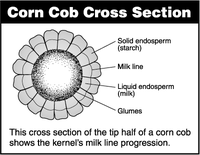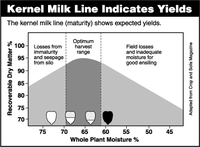September Means Corn Silage Harvest
(Click an image below to view a high-resolution image that can be downloaded)
The time to make corn silage is approaching quickly.
Late-season crops remain ahead of or near the average for maturity, with some corn chopping already under way, according to the North Dakota Agricultural Statistics Service’s recent North Dakota Crop, Livestock and Weather Report.
North Dakota State University agronomists say the average corn field in eastern North Dakota is within three weeks of the one-half milk line. However, the weather in western North Dakota has been cooler, and corn growth appears to be 10 days behind the eastern portion of the state.
“So depending where you are, and if you are ensiling corn, get ready,” says J.W. Schroeder, NDSU Extension Service dairy specialist. “The harvest and storage management decisions you make now are critical to producing the best quality corn silage possible.”
He cautions that maturity at harvest may affect corn silage quality because maturity influences grain and moisture content as well as stover digestibility.
The best way to determine the maturity of corn silage is the location of the milk line. The milk line is where the liquid and solid portions of the kernel meet. The milk line will not appear until the corn is at the dent stage of maturity.
Some hybrids do not show the milk line as readily as others, and the kernel may have to be cut lengthwise to determine the location. Producers also can determine the milk line by biting the kernels, starting at the tip of the ear.
The rule of thumb for deciding when to harvest is that corn silage quality will be optimum if the grain fill is allowed to occur until the milk line is one-half to two-thirds of the way down the kernel, Schroeder says. Animal studies indicate that optimum intake of corn silage also occurs at this maturity. Harvesting at this stage usually results in near optimum moisture content for storage of the corn silage.
Research at Pioneer Hi-Bred and the University of Minnesota indicates that when the kernels are just denting (prior to milk line formation), the whole-plant moisture will be 73 to 76 percent. Harvest at this maturity would result in lower grain content and the loss of valuable nutrients due to runoff. When the milk line is one-half to two-thirds of the way down the kernel, the whole-plant moisture will be in the range of 65 to 70 percent. This gives the best possible compromise among grain content, sugar content, stover digestibility and moisture content.
If the corn silage is to be placed in upright silos, the lower end of this moisture range should be the target moisture. When the kernels first form a black layer, the whole-plant moisture will increase harvest loss and make packing much more difficult, thus increasing storage losses.
Variations from the moisture ""rule of thumb"" can occur due to hybrid, location and weather conditions. Producers should monitor the stage of maturity and moisture content of the corn plant closely prior to beginning to harvest.
Once producers have determined the proper maturity and moisture content for harvest, the primary management concerns are to harvest the crop as quickly as possible, avoid runoff, and store and treat the corn silage in a manner that eliminates and excludes as much oxygen as possible.
“These steps will ensure a fast, efficient fermentation with minimum losses during ensiling, storage and feed-out,” Schroeder says.
NDSU Agriculture Communication
| Source: | J.W. Schroeder, (701) 231-7663, jw.schroeder@ndsu.edu |
|---|---|
| Editor: | Ellen Crawford, (701) 231-5391, ellen.crawford@ndsu.edu |



